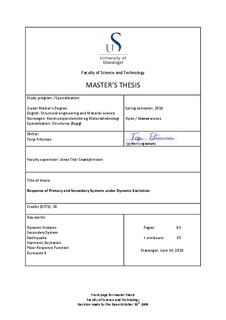| dc.description.abstract | Engineers have gained much knowledge on how a primary system behaves under harmonic
excitation and earthquakes, but they do not know as much about how a secondary system affects
the behavior. In seismic areas, buildings (primary system) are built to withstand the impact of the
earthquake, but the effects on secondary systems are often not taken into consideration when the
structure is designed.
In the past 40 years a lot of research has been done on developing methods to analyze the nonstructural
elements during seismic excitation. However, these methods were mainly focused on the
safety of critical equipment in, for example, power plants. In the later years it has been shown that
the non-structural elements in conventional buildings also should be taken into consideration in the
earthquake design process.
A floor response spectrum from the primary structure is often used to estimate the dynamic
response of the secondary system, but one problem by doing so is that it does not take into
consideration the effect of the interaction between the two systems.
The so-called Cardington Building, the primary system used in this thesis, was a seven storey in-situ
concrete building erected inside an old Zeppelin hanger which housed the Cardington Laboratory
near Bedford, UK, owned and operated by the BRE (Building Research Establishment Ltd). The
building was built in 1998, and was a part of the European Concrete Building Project (ECBP). It was
constructed like an office block, and its goal was to provide improved design codes, especially for the
dynamic properties of the concrete structure.
The analyses in this thesis are based on a numerical model of the Cardington Building made in a finite
element program called Ruaumoko. The model is calibrated against experimental results from full
scale tests performed by Jónas Thór Snæbjörnsson, Ódinn Thórarinsson and Símon Ólafsson in 2000
[2].
The FE model in this thesis is exposed to harmonic excitation in the first tests and excited by
earthquakes in the second tests. Also, the seismic coefficients obtained from the earthquake
excitations have been compared with the seismic coefficients calculated by equations from the
Eurocode 8 standard.
From the harmonic excitation tests it is seen that the secondary systems with their natural
frequencies inside the resonant frequency range of the primary system get a much higher
displacement than the ones outside the resonant frequency range, but in exchange the displacement
of the primary system is reduced. For secondary system 6 the displacement of the primary system
drops 34 % for the fourth floor and 35 % for the top floor (Figure 5.10 and Figure 5.11). This is true
for secondary systems with both 0.8 % damping and 5.0 % damping.
When the earthquake tests are performed it is seen that the floor response spectra method gives
values that are generally higher than the values computed from the numerical model when the
secondary system is attached to the primary system, see Table 5.10. It is seen that the natural
frequency and the damping ratio of the secondary system affects the response generated by the two
methods of measuring in different ways. | no_NO |
